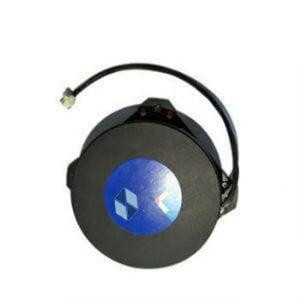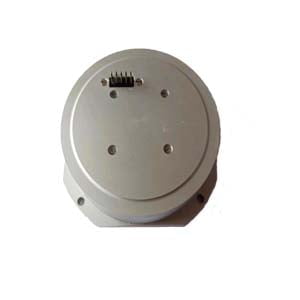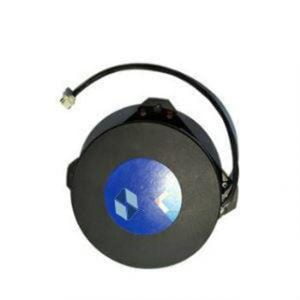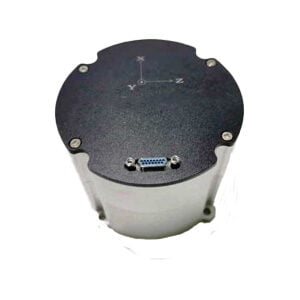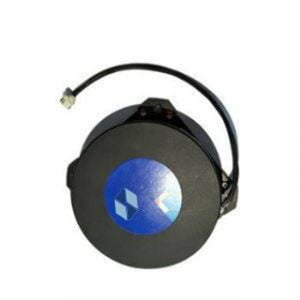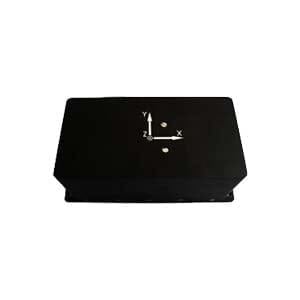1 Method of engineering structure deformation detection based on fiber optic gyroscope
The principle of the engineering structure deformation detection method based on fiber optic gyro is to fix the fiber optic gyro to the detection device, measure the angular velocity of the detection system when running on the measured surface of the engineering structure, measure the operating distance of the detection device, and calculate the operating trajectory of the detection device to realize the detection of engineering structure deformation. This method is referred to as the trajectory method in this paper. This method can be described as "two-dimensional plane navigation", that is, the position of the carrier is solved in the plumb surface of the measured structure surface, and the trajectory of the carrier along the measured structure surface is finally obtained.
According to the principle of trajectory method, its main error sources include reference error, distance measurement error and Angle measurement error. The reference error refers to the measurement error of the initial inclination Angle θ0, the distance measurement error refers to the measurement error of ΔLi, and the Angle measurement error refers to the measurement error of Δθi, which is mainly caused by the measurement error of the angular velocity of the fiber optic gyroscope. This paper does not consider the influence of reference error and distance measurement error on the deformation detection error, only the deformation detection error caused by the fiber optic gyroscope error is analyzed.
2 Analysis of deformation detection accuracy based on fiber optic gyroscope
2.1 Error modeling of fiber optic gyroscope in deformation detection applications
Fiber optic gyro is a sensor for measuring angular velocity based on Sagnac effect. After the light emitted by the light source passes through the Y-waveguide, two beams of light rotating in opposite directions in the fiber ring are formed. When the carrier rotates relative to the inertial space, there is an optical path difference between the two beams of light, and the optical interference signal related to the rotational angular speed can be detected at the detector end, so as to measure the diagonal speed.
The mathematical expression of the fiber optic gyro output signal is: F=Kw+B0+V. Where F is the gyro output, K is the scale factor, and ω is the gyro
The angular velocity input on the sensitive axis, B0 is the gyroscopic zero bias, υ is the integrated error term, including white noise and slowly varying components caused by various noises with long correlation time, υ can also be regarded as the error of zero bias.
The sources of measurement error of fiber optic gyroscope include scale factor error and zero deviation error. At present, the scale factor error of the fiber optic gyroscope applied in engineering is 10-5~10-6. In the application of deformation detection, the angular velocity input is small, and the measurement error caused by the scale factor error is much smaller than that caused by the zero deviation error, which can be ignored. The DC component of the zero-bias error is characterized by the zero-bias repeatability Br, which is the standard deviation of the zero-bias value in multiple tests. The AC component is characterized by zero bias stability Bs, which is the standard deviation of the gyroscope output value from its mean in one test, and its value is related to the sampling time of the gyroscope.
2.2 Calculation of deformation error based on fiber optic gyroscope
Taking the simple supported beam model as an example, the error of deformation detection is calculated, and the theoretical model of structural deformation is established. On this basis, the detection is set
Based on the operating speed and sampling time of the system, the theoretical angular velocity of the fiber optic gyro can be obtained. Then the angular velocity measurement error of the fiber optic gyro can be simulated according to the zero deviation error model of the fiber optic gyro established above.
2.3 Example simulation calculation
The simulation setting of running speed and sampling time adopts a range-varying mode, that is, the ΔLi passed by each sampling time is fixed, and the sampling time of the same line segment is changed by changing the running speed. For example, when the ΔLi is 1 mm, such as the running speed is 2 m/s, the sampling time is 0.5 ms. If the operating speed is 0.1 m/s, the sampling time is 10 ms.
3 Relationship between fiber optic gyroscope performance and deformation measurement error
Firstly, the effect of zero-bias repeatability error is analyzed. When there is no zero bias stability error, the angular velocity measurement error caused by zero bias error is fixed, such as the faster the motion speed, the shorter the total measurement time, the smaller the impact of zero bias error, the smaller the deformation measurement error. When the running speed is fast, the zero bias stability error is the main factor causing the system measurement error. When the running speed is low, the zero bias repeatability error becomes the main source of the system measurement error.
Using typical medium precision fiber optic gyro index, that is, zero bias stability is 0.5 °/h when sampling time is 1 s, Zero repeatability is 0.05 °/h. Compare the system measurement errors at the operating speed of 2 m/s, 1 m/s, 0.2 m/s, 0.1 m/s, 0.02 m/s, 0.01 m/s, 0.002 m/s and 0.001 m/s. When the operating speed is 2 m/s, The measurement error is 8.514μm (RMS), when the measurement speed is reduced to 0.2m /s, the measurement error is 34.089μm (RMS), when the measurement speed is reduced to 0.002m /s, the measurement error is 2246.222μm (RMS), as can be seen from the comparison results. The faster the running speed, the smaller the measuring error. Considering the convenience of engineering operation, the running speed of 2 m/s can achieve better than 10 μm measurement accuracy.
4 Summary
Based on the simulation analysis of the engineering structure deformation measurement based on fiber optic gyro, the error model of fiber optic gyro is established, and the relationship between the deformation measurement error and the performance of fiber optic gyro is obtained by using the simple supported beam model as an example. The simulation results show that the faster the system runs, that is, the shorter the sampling time of the fiber optic gyroscope, the higher the deformation measurement accuracy of the system when the sampling number is unchanged and the distance detection accuracy is guaranteed. With the typical medium precision fiber optic gyro index and the running speed of 2 m/s, the deformation measurement accuracy of better than 10 μm can be achieved.
Ericco's ER-FOG-851 has a diameter of 78.5mm and an accuracy of ≤0.05 ~ 0.1º/h. ER-FOG-910 precision 0.02º/h, belongs to the high tactical level of the fiber optic gyroscope, our company produced gyroscope with small size, light weight, low power consumption, fast start, simple operation, easy to use and other characteristics, widely used in INS, IMU, positioning system, north finding system, platform stability and other fields. If you are interested in our fiber optic gyro, please feel free to contact us.
More Technical Questions
1.Analysis of Main Performance Parameters of Fiber Optic Gyroscopecope?
2.Do you Know What Digital Fiber Optic Gyro is?
3.Research on miniaturization technology of fiber optic gyroscope
4.Ripple Free Minimum Beat Control of Closed-loop FOG Gyro
5.Analysis of Performance Index of Fiber Optic Gyroscope
6.Research on Operating Error of Fiber Optic Gyro across Stripes


